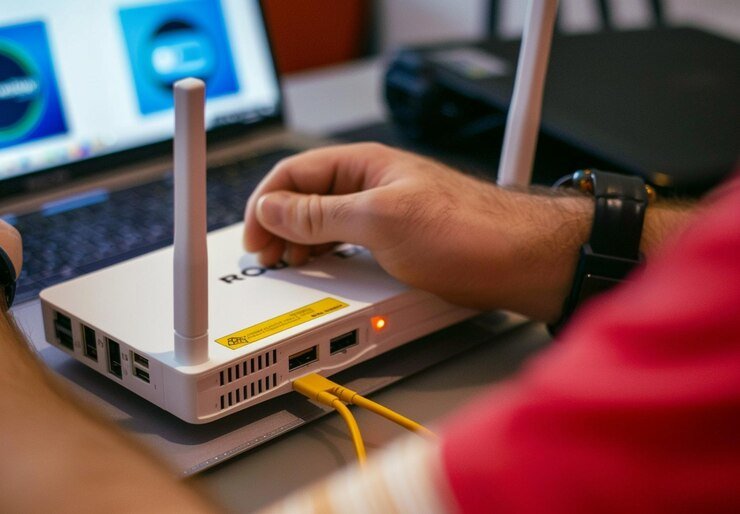
Introduction to IPv6
The digital landscape is constantly evolving, and one of the most significant shifts in recent years has been the adoption of IPv6 addressing. As we venture deeper into an era where connectivity plays a crucial role in our lives, understanding IPv6 details becomes essential for anyone interested in technology or networking.
IPv4 served us well for decades, but with billions of devices coming online every day, it simply can’t keep up anymore. So what exactly is this new standard? Why should you care about it? This guide will take you through everything you need to know about IPv6 — from its structure and advantages to implementation challenges and troubleshooting tips. Get ready to dive into the world of IPv6!
The Need for IPv6 Addressing
The rapid growth of the internet has brought a pressing challenge. The explosion of devices—smartphones, tablets, IoT gadgets—demands more IP addresses than IPv4 can provide.
IPv4 offers approximately 4.3 billion unique addresses. This might sound like a lot, but with billions online and new devices emerging daily, we’re quickly running out.
IPv6 steps in as the solution. It supports an astronomical number of addresses: over 340 undecillion (that’s 34 followed by 38 zeros). This expansion is vital for our connected world.
Without IPv6, areas such as smart cities and autonomous vehicles could face connectivity issues. Transitioning to this newer protocol ensures that innovation continues without restriction or delay in addressing capabilities.
As technology evolves at lightning speed, so must our infrastructure to support it effectively. Embracing IPv6 is no longer optional; it’s essential for future-proofing digital communication.
Differences between IPv4 and IPv6 Addresses
IPv4 and IPv6 addresses serve the same fundamental purpose: identifying devices on a network. However, they differ significantly in structure and capacity.
IPv4 uses a 32-bit address scheme, which allows for around 4.3 billion unique addresses. This may sound sufficient, but with the explosive growth of internet-connected devices, it quickly became apparent that more addresses were needed.
On the other hand, IPv6 employs a 128-bit addressing format. This monumental leap provides an almost unfathomable number of unique IP addresses—about 340 undecillion (that’s 34 followed by 36 zeros).
The representation also varies; while IPv4 is written as four decimal numbers separated by periods (e.g., 192.168.1.1), IPv6 utilizes hexadecimal notation divided into eight groups (e.g., 2001:0db8:85a3:0000:0000:8a2e:0370:7334).
These differences highlight not just improved capacity but also enhanced functionality designed to accommodate future needs in networking technology.
How to Read an IPv6 Address
Reading an IPv6 address might seem daunting at first, but it’s quite straightforward once you grasp the basics. An IPv6 address is composed of eight groups of four hexadecimal digits. Each group is separated by a colon.
For instance, in the address 2001:0db8:85a3:0000:0000:8a2e:0370:7334, each segment holds significant information about routing and location on the network.
You can abbreviate consecutive zeros to simplify the representation. So instead of writing out all those zeros, you could express that as 2001:db8:85a3::8a2e:370:7334—just remember that this double colon can only appear once in an address.
Understanding these components helps identify subnets and hosts within your network infrastructure better than before. Familiarizing yourself with this structure opens up new possibilities for effective networking management.
Advantages of Using IPv6 Addressing
IPv6 addressing offers several compelling advantages that benefit both users and network administrators. One of the major improvements is the vast address space it provides. With over 340 undecillion unique addresses, IPv6 virtually eliminates the risk of running out of IP addresses.
Another significant perk is enhanced security features integrated within its design. IPv6 supports Internet Protocol Security (IPsec) natively, ensuring secure data transmission across networks.
Performance also sees a boost with IPv6 due to simplified packet headers. This streamlining allows routers to process packets more efficiently, leading to faster connectivity.
Additionally, IPv6 improves support for mobile devices through better routing capabilities and streamlined connections. As our world becomes increasingly mobile-centric, these enhancements are critical for efficient communication.
Automatic configuration simplifies device setup on networks without manual input or complex configurations needed in previous versions like IPv4.
Challenges with Implementing IPv6
Transitioning to IPv6 can be a daunting task for many organizations. One major challenge lies in the lack of awareness and understanding among IT staff. Training is essential, yet often overlooked.
Another hurdle is compatibility with existing infrastructure. Many legacy systems still rely on IPv4, making integration complex and costly. This can lead to fragmentation within networks, causing performance issues.
Additionally, there are security concerns. While IPv6 has built-in features like IPsec, not all devices support these protocols uniformly. This inconsistency might expose networks to vulnerabilities during the transition period.
Moreover, the adoption rates vary globally. Some regions are ahead in implementation while others lag behind significantly. This uneven landscape complicates interconnectivity between different areas.
Budget constraints can hinder progress as upgrading network hardware or software typically requires considerable investment that some businesses may find difficult to allocate.
Tips for Transitioning to IPv6
Transitioning to IPv6 can seem daunting, but it doesn’t have to be. Start with a clear plan. Assess your current network infrastructure and identify the devices that need an upgrade.
Educate your team about IPv6 details. Understanding its structure and functionalities is crucial for smooth implementation. Conduct training sessions or workshops if necessary.
Gradually implement dual-stack networks, allowing both IPv4 and IPv6 to operate simultaneously. This approach minimizes disruption while you transition.
Utilize tools for monitoring and troubleshooting during the shift. They help pinpoint issues early on, ensuring a seamless migration experience.
Keep communication open among stakeholders throughout the process. Sharing progress updates fosters collaboration and eases concerns related to the changeover.
Benefits of IPv6 Addressing
IPv6 addressing brings a wealth of benefits that cater to the growing needs of modern networks. One significant advantage is the vast address space it offers. Unlike IPv4, which has about 4 billion addresses, IPv6 can accommodate an almost limitless number of unique IP addresses.
This expansion supports the increasing number of devices connected to the internet. With IoT (Internet of Things) rapidly evolving, having ample addresses ensures seamless connectivity for smart devices and applications.
Another crucial benefit is improved network efficiency. IPv6 simplifies routing and reduces overhead by allowing hierarchical address allocation. This leads to faster data transmission and less congestion on networks.
Security features are also enhanced in IPv6 with mandatory support for IPsec, making communication more secure right from the start. These advantages position IPv6 as a future-ready solution for global networking challenges.
The Structure of an IPv6 Address
An IPv6 address comprises 128 bits, displayed as eight groups of four hexadecimal digits. Each group is separated by colons, making it easier to read and manage.
These hexadecimal blocks represent 16 bits each. When combined, they create a vast number of possible addresses—about 340 undecillion. This immense capacity is crucial for supporting the growing number of devices connected to the internet.
A significant feature of IPv6 addressing is zero compression. If there are consecutive groups of zeros, you can replace them with a double colon (::) once per address. For example, instead of writing out all zeros repeatedly, you simplify it significantly.
Additionally, the structure includes various types such as network prefix and interface identifier portions. The first portion identifies the network while the latter distinguishes devices on that network. Understanding this format helps in efficient routing and management across networks globally.
Types of IPv6 Addresses: Unicast, Multicast, and Anycast
IPv6 addresses come in three primary types: unicast, multicast, and anycast. Each serves a unique purpose within the network ecosystem.
Unicast addresses identify a single interface on a device. When data packets are sent to a unicast address, they arrive at one specific destination. It’s like sending mail directly to one person’s mailbox.
Multicast addresses enable communication with multiple devices simultaneously. A packet sent to a multicast address reaches all subscribed interfaces at once. This method is efficient for applications such as streaming media or video conferencing.
Anycast addresses also cater to multiple devices but differ in their delivery mechanism. The packet goes to the nearest device that shares the same anycast address, optimizing response time and reducing latency across networks.
Understanding these distinctions helps in efficiently managing network resources and enhancing performance while using IPv6 addressing schemes.
How to Configure and Assign IPv6 Addresses
Configuring and assigning IPv6 addresses is essential for modern networks. Begin by ensuring your device supports IPv6. Most operating systems today do.
To assign an IPv6 address manually, access the network settings on your device. Input the desired address, which should be in hexadecimal format divided by colons.
For automatic assignment, enable Stateless Address Autoconfiguration (SLAAC). This allows devices to generate their own addresses based on the local network prefix.
Alternatively, use DHCPv6 for a more controlled approach. Set up a DHCP server that can allocate specific addresses to devices as they connect.
Remember to define subnet prefixes carefully; this ensures efficient routing across your network. Always document assigned addresses to prevent conflicts later on.
Monitoring tools can help verify configurations and identify any issues promptly. Regular checks maintain smooth communication within your infrastructure.
Troubleshooting Common Issues with IPv6 Addressing
Troubleshooting IPv6 can sometimes feel daunting. Common issues often stem from misconfigurations or compatibility problems with older systems.
One frequent headache is connectivity failures. Begin by verifying your network settings. Ensure that the correct IPv6 address is assigned and check if the router supports IPv6 traffic.
Another challenge might be related to DNS resolution. If you encounter slow name resolutions, inspect your DNS server settings for proper configuration of AAAA records.
Firewall rules can also create obstacles. Make sure that both inbound and outbound rules permit IPv6 traffic, as some default configurations may block these packets entirely.
Keep an eye on link-local addresses during troubleshooting. They are essential for local communication but can lead to confusion if not properly recognized across devices in the network.
Future of IPv6 Addressing
The future of IPv6 addressing is bright and filled with potential. As the internet continues to expand, the need for more unique addresses becomes critical. IPv6 offers a virtually limitless pool of IP addresses, ensuring connectivity for billions of devices.
We can expect an increase in IoT (Internet of Things) applications that will rely heavily on IPv6. Smart homes, connected vehicles, and industrial automation depend on efficient addressing systems.
Moreover, as businesses migrate to cloud solutions, adopting IPv6s can streamline communication across diverse networks. Enhanced security features built into the protocol also promise safer transactions and interactions online.
As countries invest in digital infrastructure, embracing IPv6s will become essential for global competitiveness. Future innovations hinge on seamless connectivity powered by this advanced addressing system. The push towards full implementation is not just necessary; it’s inevitable as we look ahead to an increasingly interconnected world.
Conclusion
Understanding IPv6 addressing is crucial in today’s digital landscape. As the internet continues to grow, so does the need for a more robust and expansive addressing system. By transitioning to IPv6s, organizations can enhance connectivity, improve security features, and ensure their systems are future-proof.
IPv6s offers numerous benefits over its predecessor, IPv4. Its vast address space addresses the limitations of IP exhaustion while providing efficient routing mechanisms. Although challenges exist during implementation, careful planning and execution can lead to successful adoption.
As we move forward into an increasingly connected world, embracing IPv6s becomes not just beneficial but necessary for sustaining growth and innovation in technology. Staying informed about ipv6s details will empower individuals and businesses alike to navigate this evolving landscape effectively.
RELATED POSTS
View all


